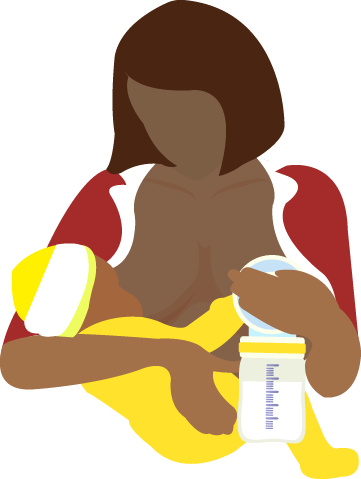Undernutrition is estimated to be associated with 2.7 million child deaths annually or 45% of all child deaths. Infant and young child feeding is a key area to improve child survival and promote healthy growth and development. The first 2 years of a child’s life are particularly important, as optimal nutrition during this period lowers morbidity and mortality, reduces the risk of chronic disease, and fosters better development overall.
Optimal breastfeeding is so critical that it could save the lives of over 820 000 children under the age of 5 years each year.
WHO and UNICEF recommend:
early initiation of breastfeeding within 1 hour of birth;
exclusive breastfeeding for the first 6 months of life; and
introduction of nutritionally-adequate and safe complementary (solid) foods at 6 months together with continued breastfeeding up to 2 years of age or beyond.
However, many infants and children do not receive optimal feeding. For example, only about 44% of infants aged 0–6 months worldwide were exclusively breastfed over the period of 2015-2020.
Recommendations have been refined to also address the needs for infants born to HIV-infected mothers. Antiretroviral drugs now allow these children to exclusively breastfeed until they are 6 months old and continue breastfeeding until at least 12 months of age with a significantly reduced risk of HIV transmission.
Breastfeeding
Exclusive breastfeeding for 6 months has many benefits for the infant and mother. Chief among these is protection against gastrointestinal infections which is observed not only in developing but also industrialized countries. Early initiation of breastfeeding, within 1 hour of birth, protects the newborn from acquiring infections and reduces newborn mortality. The risk of mortality due to diarrhoea and other infections can increase in infants who are either partially breastfed or not breastfed at all.
Breast-milk is also an important source of energy and nutrients in children aged 6–23 months. It can provide half or more of a child’s energy needs between the ages of 6 and 12 months, and one third of energy needs between 12 and 24 months. Breast milk is also a critical source of energy and nutrients during illness, and reduces mortality among children who are malnourished.
Children and adolescents who were breastfed as babies are less likely to be overweight or obese. Additionally, they perform better on intelligence tests and have higher school attendance. Breastfeeding is associated with higher income in adult life. Improving child development and reducing health costs results in economic gains for individual families as well as at the national level.(1)
Longer durations of breastfeeding also contribute to the health and well-being of mothers: it reduces the risk of ovarian and breast cancer and helps space pregnancies–exclusive breastfeeding of babies under 6 months has a hormonal effect which often induces a lack of menstruation. This is a natural (though not fail-safe) method of birth control known as the Lactation Amenorrhoea Method.
Mothers and families need to be supported for their children to be optimally breastfed. Actions that help protect, promote and support breastfeeding include:
adoption of policies such as the International Labour Organization’s “Maternity Protection Convention 183” and “Recommendation No. 191”, which complements “Convention No. 183” by suggesting a longer duration of leave and higher benefits;
adoption of the “International Code of Marketing of Breast-milk Substitutes” and subsequent relevant World Health Assembly resolutions;
implementation of the “Ten Steps to Successful Breastfeeding” specified in the Baby-Friendly Hospital Initiative, including:
skin-to-skin contact between mother and baby immediately after birth and initiation of breastfeeding within the first hour of life;
breastfeeding on demand (that is, as often as the child wants, day and night);
rooming-in (allowing mothers and infants to remain together 24 hours a day);
not giving babies additional food or drink, even water, unless medically necessary;
provision of supportive health services with infant and young child feeding counselling during all contacts with caregivers and young children, such as during antenatal and postnatal care, well-child and sick child visits, and immunization; and
community support, including mother support groups and community-based health promotion and education activities.
Breastfeeding practices are highly responsive to supportive interventions, and the prevalence of exclusive and continued breastfeeding can be improved over the course of a few years.
Complementary feeding
Around the age of 6 months, an infant’s need for energy and nutrients starts to exceed what is provided by breast milk, and complementary foods are necessary to meet those needs. An infant of this age is also developmentally ready for other foods. If complementary foods are not introduced around the age of 6 months, or if they are given inappropriately, an infant’s growth may falter. Guiding principles for appropriate complementary feeding are:
continue frequent, on-demand breastfeeding until 2 years of age or beyond;
practise responsive feeding (for example, feed infants directly and assist older children. Feed slowly and patiently, encourage them to eat but do not force them, talk to the child and maintain eye contact);
practise good hygiene and proper food handling;
start at 6 months with small amounts of food and increase gradually as the child gets older;
gradually increase food consistency and variety;
increase the number of times that the child is fed: 2–3 meals per day for infants 6–8 months of age and 3–4 meals per day for infants 9–23 months of age, with 1–2 additional snacks as required;
use fortified complementary foods or vitamin-mineral supplements as needed; and
during illness, increase fluid intake including more breastfeeding, and offer soft, favourite foods.
Source: WHO




